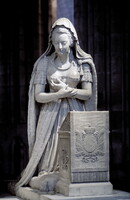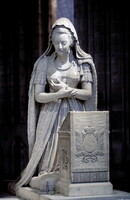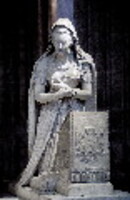| dc.coverage.spatial | Site: Saint-Denis, Île-de-France, France | en_US |
| dc.coverage.temporal | ca. 1400-1850 (inclusive) | en_US |
| dc.creator | L'Orme, Philibert de | en_US |
| dc.creator | Primaticcio, Francesco | en_US |
| dc.creator | Petitot, Pierre | en_US |
| dc.creator | Pilon, Germain | en_US |
| dc.date | 1400-1850 | en_US |
| dc.date.accessioned | 2013-03-19T17:24:48Z | |
| dc.date.available | 2013-03-19T17:24:48Z | |
| dc.date.issued | 1400-1850 | en_US |
| dc.identifier | 200845 | en_US |
| dc.identifier.other | archrefid: 1201 | en_US |
| dc.identifier.uri | http://hdl.handle.net/1721.3/108607 | |
| dc.description | Tomb of Louis XVI & Marie-Antoinette, view of Marie-Antoinette; The change during the Renaissance in attitudes towards the affirmation of the individual is reflected in the later royal tombs at Saint-Denis. As with the medieval tombs, some were commissioned for the abbey, while others were brought in at a later date from their original places in various Paris churches, having been dismantled during the Revolution and re-erected under the Restoration after the closure of Alexandre Lenoir's Musée des Monuments Français. All these monuments were later installed in new sites, most recently in the chancel of the church, where they constitute both a museum of the Kings of France and an important display of French funerary sculpture. The tomb of the Dukes of Orléans, formerly in the Celestine church, Paris (destroyed 1795), was commissioned by Louis XII in 1502 and was the first to reveal signs of a taste for the Italian style. The tomb of Louis XII and Anne of Brittany commissioned by Francis I in 1516, was completed only in 1531. The tomb of Francis I and Claude of France, commissioned by Henry II from Philibert de L'Orme in 1548, reveals a similar spirit but is still more grandiose in design and execution; it gives the impression of being an independent building, a triumphal arch constructed entirely in white marble. In 1817, as a part of his attempts to wipe out all traces of the Revolution, Louis XVIII commissioned Edme Gaulle (1762-1841) and Pierre Petitot (1760-1840) to execute figures of Louis XVI and Marie-Antoinette respectively; the statues depict the monarchs in their coronation robes and were based on the type of praying figures produced in the Renaissance. Source: Grove Art Online; http://www.groveart.com/ (accessed 2/3/2008) | en_US |
| dc.format.medium | marble | en_US |
| dc.rights | © Scott Gilchrist, Archivision, Inc. | en_US |
| dc.subject | death or burial | en_US |
| dc.subject | portraits | en_US |
| dc.subject | rulers and leaders | en_US |
| dc.subject | Francis I, King of France, 1494-1547 | en_US |
| dc.subject | Medieval | en_US |
| dc.subject | Renaissance | en_US |
| dc.subject | Nineteenth century | en_US |
| dc.subject | Baroque | en_US |
| dc.title | Saint-Denis: Royal Tombs | en_US |
| dc.type | image | en_US |
| dc.rights.access | Licensed for educational and research use by the MIT community only | en_US |
| dc.identifier.vendorcode | 1A2-F-P-SD-3-B4 | en_US |
| vra.culturalContext | French | en_US |
| vra.technique | carving (processes) construction (assembling) | en_US |
| vra.worktype | tomb | en_US |
| vra.worktype | monument | en_US |
| vra.worktype | sculpture (visual work) | en_US |
| dc.contributor.display | Francesco Primaticcio (Italian designer, 1504-1570); Germain Pilon (French sculptor, ca. 1525-1590); Philibert de L'Orme (French designer, ca. 1510-1570); Pierre Petitot (French sculptor, 1760-1840) and others | en_US |



